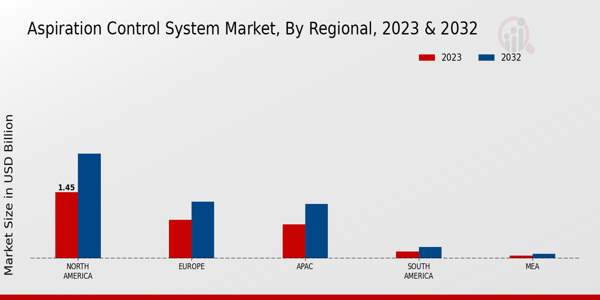Regulatory Compliance
Regulatory compliance plays a pivotal role in shaping the Global Aspiration Control System Market Industry. Stringent regulations imposed by health authorities and safety organizations necessitate the use of high-quality aspiration systems that meet specific standards. Manufacturers are compelled to innovate and enhance their products to comply with these regulations, which can lead to improved safety and efficacy in various applications. This compliance not only fosters consumer trust but also drives market growth as organizations seek to avoid penalties and ensure operational continuity. The anticipated growth trajectory from 3.59 USD Billion in 2024 to 6.04 USD Billion by 2035 underscores the importance of adherence to regulatory frameworks.
Market Growth Projections
The Global Aspiration Control System Market Industry is poised for substantial growth, with projections indicating an increase from 3.59 USD Billion in 2024 to 6.04 USD Billion by 2035. This growth trajectory is supported by a compound annual growth rate (CAGR) of 4.84% from 2025 to 2035. The market's expansion is driven by various factors, including technological advancements, increasing healthcare demands, and rising industrial applications. As organizations continue to invest in innovative aspiration control systems, the market is likely to witness a robust transformation, catering to the evolving needs of diverse sectors.
Technological Advancements
The Global Aspiration Control System Market Industry is experiencing rapid technological advancements that enhance system efficiency and performance. Innovations in automation and control technologies are enabling more precise aspiration processes, which are crucial in various applications such as medical devices and industrial machinery. For instance, the integration of artificial intelligence and machine learning algorithms is streamlining operations and reducing human error. As a result, the market is projected to grow from 3.59 USD Billion in 2024 to 6.04 USD Billion by 2035, reflecting a compound annual growth rate (CAGR) of 4.84% from 2025 to 2035.
Rising Industrial Applications
The Global Aspiration Control System Market Industry is witnessing a surge in demand from various industrial sectors, including food processing, pharmaceuticals, and manufacturing. These industries require efficient aspiration systems to maintain product quality and operational efficiency. For example, in food processing, aspiration systems are essential for removing contaminants and ensuring hygiene standards. As industries increasingly prioritize automation and efficiency, the adoption of advanced aspiration control systems is likely to rise. This trend contributes to the market's growth, with projections indicating an increase from 3.59 USD Billion in 2024 to 6.04 USD Billion by 2035, reflecting a CAGR of 4.84% from 2025 to 2035.
Increasing Demand in Healthcare
The healthcare sector is a significant driver of the Global Aspiration Control System Market Industry, as the need for efficient and reliable aspiration systems continues to rise. With the growing prevalence of chronic diseases and the aging population, healthcare facilities are increasingly adopting advanced aspiration systems for surgical procedures and patient care. These systems ensure the safe removal of fluids and debris, thereby improving patient outcomes. The market's expansion is supported by investments in healthcare infrastructure, which further propels the demand for aspiration control systems, aligning with the projected growth from 3.59 USD Billion in 2024 to 6.04 USD Billion by 2035.
Market Resilience and Adaptability
The Global Aspiration Control System Market Industry demonstrates resilience and adaptability in the face of changing economic conditions. Companies are increasingly focusing on developing versatile aspiration systems that can be tailored to meet diverse customer needs across various sectors. This adaptability not only enhances market competitiveness but also allows manufacturers to respond effectively to fluctuations in demand. As businesses seek to optimize their operations and reduce costs, the ability to provide customized solutions becomes a key differentiator. The market's projected growth from 3.59 USD Billion in 2024 to 6.04 USD Billion by 2035 reflects this resilience and the ongoing evolution of aspiration control systems.















